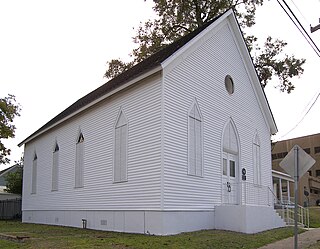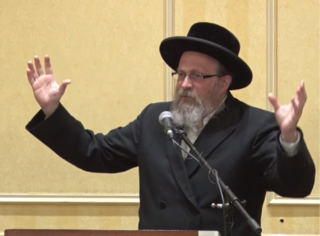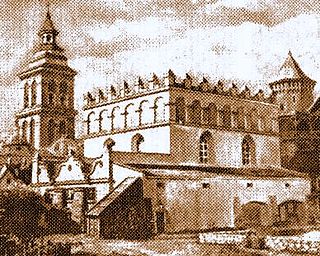| Jakob Glanzer Shul | |
|---|---|
 | |
| Status | Active |
| Location | |
| Location | Lviv, Ukraine |
| Architecture | |
| Style | Baroque Revival |
| Completed | 1844 |
The Jakob Glanzer Shul, or the former Chasidim Synagogue, is a synagogue at the Vuhil'na (Coal) Street Nr.3 in Lviv, Ukraine.
| Jakob Glanzer Shul | |
|---|---|
 | |
| Status | Active |
| Location | |
| Location | Lviv, Ukraine |
| Architecture | |
| Style | Baroque Revival |
| Completed | 1844 |
The Jakob Glanzer Shul, or the former Chasidim Synagogue, is a synagogue at the Vuhil'na (Coal) Street Nr.3 in Lviv, Ukraine.
The synagogue was built from 1841 to 1844 in a Baroque Revival style. Its construction was financed by Lvov merchant Jacob Glanzer, and in his honor named the "Jacob Glanzer Shul". In 1844 Jacob Glanzer's synagogue was the second-largest synagogue, after the Great city synagogue. The synagogue has been constructed in a complex with two stores. There was a prayer hall and two tiers of galleries for women were attached. And two tiers of balconies over the west side of the Shul which was destroyed by the Soviets in the years 1959/60 (Noted by Rabbi B.Vernik) It was also the location (only*) of a mikveh. Noted rabbi David Kahane, author of a memoir about the Holocaust, worked in the synagogue. During the Soviet period, ( after 1960 ) it was used as a gym.
On the end of year 1958 a few months before we left Lvov my parents donated our own bath tub from our home on the Kalinina Street -(today Zamarstunivska Street) *helping to build a mikveh, at this time there wasn't a mikveh on the premises, - ( The mikveh was on Pidval’na Street ) right afterwards the Soviets closedown the Shul! ( Noted by Rabbi B. Vernik ).
After the Second World War in this Synagogue served as a Rabbi Yaakov Gur-Aryeh which was the main spiritual leader of the Jewish community in Lvov. After the death of Rabbi Yaakov Gur-Aryeh Soviets closed the synagogue took literally everything and removed all the Sifrei Torah. that was considered to be in the hundreds and were in the synagogue, not only in the Aron Kodesh but also in the cabinets below each window of the synagogue were these all Sifrei Torah were accommodate. ( Torah Scrolls ) from all destroyed synagogues of the city and they have moved them directly to Moscow and the premises handed over to an Institute. The main prayer hall was converted to a Sports Hall, the western two tiers of galleries for women were dismantled, the beautiful murals on the walls and ceiling were over painted, the Aron Kodesh ( Torah Ark ) dismantled. Wall cabinets and all the nice furniture of the synagogue was dismantled. (( Amended by Rabbi B. Vernik who lived, grew up and studied in 58, then in 19 schools in Lviv after the war, until the day of the opening of the TV station on the High Castle Mount in the end of year 1958. )) The Synagogue was the main concourse despite of all this horror of Stalin's and after Stalin's dark days - a lot of people disappeared send to Siberia and have been killed.
The Prayers in this Shul were very, very warm with a lot of hope for much better times ! On the High Jewish holidays in the synagogue were thousands of people, but on Yom Kippur, it was just impossible to move, not only in the synagogue, as well as in the hallway and even a lot more of this, the Street of the Shul on afternoon so many people arrived and congregate, mainly students, who stood and talked quietly among themselves and waited for the Blow of the Shoifor, listening to the sound of the Shoifor which symbolized the end of Yom Kippur. In the great Hall of the synagogue could be heard "the thundering " wonderful voice of the 85 years old a famous **Cantor Boruch Leib Shulman. In the small Hall across the corridor were praying the Talmidej Chahomim and many Chasidim of different backgrounds and mostly were without a beard. On Saturdays there were three praying groups (Minion), one early morning at five o'clock in the morning, because they have to go to work early, a second group at seven o'clock in the morning, and the third group the talmidej chachomim and a lot of the Hasidim on nine o'clock Minion. On the weekdays there were every day Minyanim. On the Shul back yard were working two Shochatim for chicken. On the Succoth holiday there were a Suka - this all was happened in a horrible Stalin's and after Stalin's days between the years of 1946 -1958 – ( this is my testimony and a witness from my very young age. )
By Rabbi B. Vernik.
Since 1989 it has been used as a center of Jewish culture, the "Sholom Aleichem Jewish Culture Society". External walls of a building were repaired in 1990. (The window immured on the left side is the external indicator of the location of the Holy Ark.)

Rabbi Yekusiel Yehuda Teitelbaum (1808–1883), known as the Yetev Lev, was a Hasidic Rebbe in Austria-Hungary.

Agudas Chassidei Chabad is the umbrella organization for the worldwide Chabad-Lubavitch movement. The chairman of the executive committee is Rabbi Abraham Shemtov.

Kalonymus Kalman Shapira, was the Grand Rabbi of Piaseczno, Poland, who authored a number of works and was murdered by the Nazis during the Holocaust.
Gateshead Talmudical College, popularly known as Gateshead Yeshiva, is located in the Bensham area of Gateshead in North East England. It is the largest yeshiva in Europe and considered to be one of the most prestigious advanced yeshivas in the Orthodox world. The student body currently numbers approx. 350. Although students are mainly British, there are European, American, Canadians as well as some from South America, Australia and South Africa.

The B'nai Abraham congregation in Brenham, Texas, was organized in 1885.

Rabbi Moshe Weinberger is an American Chasidic rabbi, outreach educator, author, translator, and speaker. He is the founding rav of Congregation Aish Kodesh in Woodmere, New York, and former Mashpia/mashgiach ruchani at the Rabbi Isaac Elchanan Theological Seminary (RIETS). To date, he has recorded more than 5000 lectures on chasidic thought and philosophy as well as halacha and a variety of other topics in Judaism.
Shloime Mikhelevich Shleifer was born on December 23, 1889 in Moscow. His father was the rabbi of Alexandria, a town near Kherson. During the First World War, the Shlifer family moved to Moscow, where Rabbi Shleifer worked as a bookkeeper until 1943. He also served as the secretary of the Choral Synagogue. In 1941, he attempted to register for military service, but was turned down because of his age.

The Tsori Gilod Synagogue, also known as Beis Aharon V'Israel Synagogue, is the only functioning Jewish Orthodox synagogue in Lviv, Ukraine.

The Golden Rose Synagogue, known also as the Nachmanowicz Synagogue, or the Turei Zahav Synagogue was a synagogue in Lviv, western Ukraine. The Golden Rose Synagogue was the oldest synagogue in what is now Ukraine.

Breed Street Shul, also known as Congregation Talmud Torah of Los Angeles or Breed Street Synagogue, is an Orthodox Jewish synagogue in the Boyle Heights section of Los Angeles, California. It was the largest Orthodox synagogue west of Chicago from 1915 to 1951, and is listed in the National Register of Historic Places.

Sifrei Kodesh, commonly referred to as sefarim, or in its singular form, sefer, are books of Jewish religious literature and are viewed by religious Jews as sacred. These are generally works of Torah literature, i.e. Tanakh and all works that expound on it, including the Mishnah, Midrash, Talmud, and all works of halakha, Musar, Hasidism, Kabbalah, or machshavah. Historically, sifrei kodesh were generally written in Hebrew with some in Judeo-Aramaic or Arabic, although in recent years, thousands of titles in other languages, most notably English, were published. An alternative spelling for 'sefarim' is seforim.
Temple B'rith Kodesh is a Reform synagogue in Rochester, New York. It is the oldest synagogue and the largest Reform congregation in the greater Rochester area.

Aaron L. Raskin is an American Chabad Lubavitch rabbi and writer. He serves as spiritual leader of Congregation B'nai Avraham, an Orthodox synagogue in Brooklyn Heights, New York, and dean of Brooklyn Heights Jewish Academy.
The Yad Yisroel is a non-profit 501(c)(3) organization founded by the Stoliner rebbe in 1990 to work with Jews from the former Soviet Union. It has established community projects and schools in Kyiv, Lviv, Minsk, Pinsk and Khmelnytski.
Congregation Shomrei Emunah is an Orthodox Jewish synagogue located in Borough Park, Brooklyn, New York. Founded in 1907, the congregation moved into its present edifice in 1910. Its current rabbinical leader is Rabbi Aviezer Cohen. Its current chazzan (cantor) is Chazzan Adler. The chazzan sheini is Chazzan Nachman Schneider

The Klausen Synagogue is nowadays the largest synagogue in the former Prague Jewish ghetto and the sole example of an early Baroque synagogue in the ghetto. Today the synagogue is administered by the Jewish Museum in Prague.
Moshe Rosen, known by the name of his magnum opus, Nezer HaKodesh on Kodashim, was a Polish Orthodox rabbi who befriended the Chazon Ish while serving as a rabbi in Lithuania and later became a well respected Torah scholar in the United States of America.
Zinovy Shulman, was a Soviet Jewish singer (tenor) known for singing Yiddish art songs. He was the son of the cantor Borukh Leib Shulman (1870-1963) and was great-grandson of the writer Kalman Schulman (1819-1899). He was one of the most popular Yiddish singers in the Soviet Union alongside some of his contemporaries such as Mikhail Alexandrovich, Emil Gorovets, Anna Guzik, and Sidi Tal.
Timeline of attacks against synagogues in Israel documents anti-Semitic attacks and vandalism against synagogue buildings and property in Israel. Vandalism of synagogues is not uncommon in Israel.